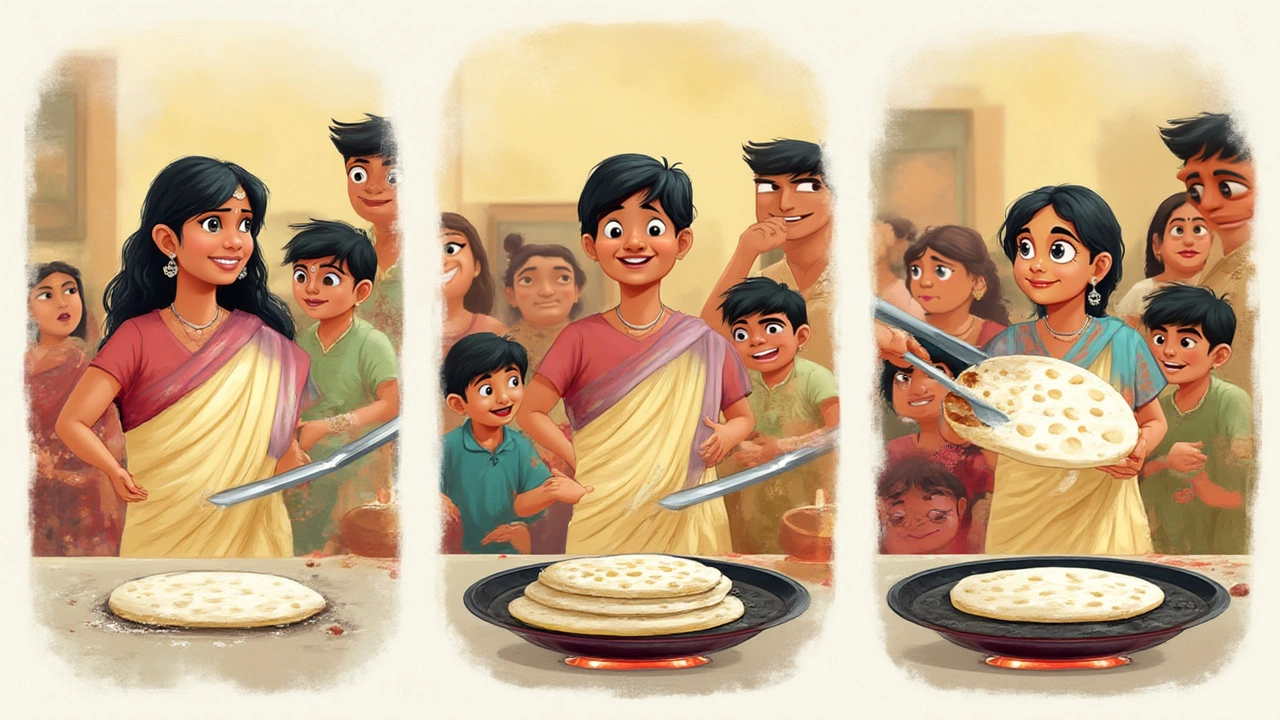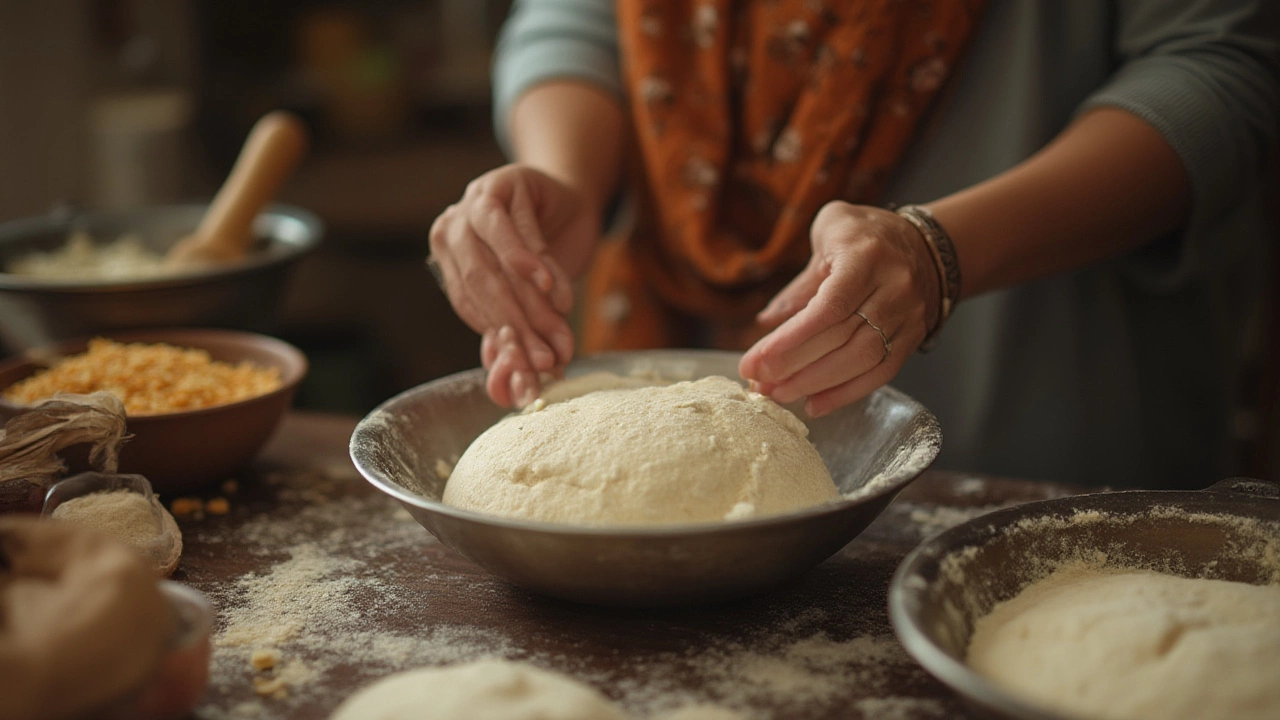If your roti sits stubbornly flat on the tawa—no drama, no puffing, just a sad pancake—you’re not alone. Most of us have been there. The first time I tried to impress my partner with puffy phulka in our tiny kitchen, the result was flatter than Luna’s favorite frisbee after a fetch marathon. But actually, these letdowns are sneakily helpful. They push you to get curious about gluten, flour, heat, and that subtle, quiet moment when a round blob of dough bursts into a balloon. Turns out, there’s nothing mysterious about it. No family secret required. It’s about science mixed with a bit of timing, some feel, and a touch of play. Grab a rolling pin and let’s crack this together.
The Exact Science of a Puffing Roti
If I could sum up the roti puffing process in a nutshell, it’s all about trapped steam. When you place a rolled-out dough disc on a hot tawa, the outer layers cook and seal quickly, while the inside tries to catch up. As the heat rushes in, water in the still-raw center turns to steam, inflates the cooked surface, and makes the roti puff like magic. That’s why both the dough and how you cook it matter so much.
The key player here is gluten: the protein web in your wheat flour. It’s what gives that little disc of dough its stretch, lets it hold shape, and creates a pocket that steam can inflate. If the gluten network is weak—maybe you used a flour with low protein, or didn’t knead long enough—the roti can’t trap the steam, so no puff. Sometimes, the shape or thickness of your roti causes problems. If one spot is thinner or thicker than the rest, steam leaks and the puff never happens.
Even the water temperature matters when making the dough. Warm water (not hot) helps gluten develop but keeps the dough soft. Too little water? You’ll get a tough, dry dough. Too much? Sticky, stretchy, and no structure for steam. Most busy Indian kitchens work on a 2:1 flour-to-water ratio by volume, but I’ve found that 1 cup flour to 1/3 cup warm water usually gets you started; adjust as needed so your dough becomes smooth and just barely sticky to the touch. Salt’s useful for taste and gluten structure, but don’t add oil or ghee at this point. That comes later.
The resting period is where folks mess up without realizing. Give your dough at least 20-30 minutes to chill under a damp cloth—the gluten relaxes, starches hydrate, and you get that pillowy texture inside. Skip this and you risk stiff, flat rotis. My tip? If Luna’s patiently waiting for her walk, leave your dough to rest till you’re back. It’ll only get better.
Here’s a quick comparison for context (per 100g flour):
| Factor | Puffed Roti | Flat Roti |
|---|---|---|
| Flour Type (Protein %) | 12% or higher (atta) | Lower (maida/all-purpose) |
| Kneading Time | 8-10 minutes | Under 3 minutes |
| Water Content | Just enough for soft, pliable dough | Too little or too much |
| Resting time | 20-30 mins | No rest |
To sum up: the roti not puffing is almost always a gluten, water, or temperature issue. Flattened dreams are actually your dough talking back to you. Listen up.

Rolling, Cooking, and the Ritual of the Tawa
So you nailed the dough, but now your roti’s still lounging on the pan like it’s at the spa, refusing to puff. What gives? Allow me to admit: the way you roll and cook your roti is at least half the story. I once let my cousin (bless her) roll some rotis as thick as a coaster and cook them on a low flame. Not a single one puffed, but we had plenty of laughs and made great roti chips for Luna.
Let’s start with rolling. Uniform thickness is everything. Your roti should be even—no bulges, no patches. Use gentle pressure, turning the disc after every roll. If you press too hard or skip turning, you get uneven areas, which means weak steam pockets and leaky puffing. I love a wooden rolling board, but marble works if that’s what you’ve got. Just dust with atta lightly—too much, and the surface dries out before hitting the pan.
Second: size. Ideal roti is about 6 inches diameter and 1-2 mm thick. Thicker than that, and heat can’t reach the middle. Too thin, and the dough has no steam trap. Use your hands and eyes here, not gadgets, and don’t stress over small flaws. Each roti gets better.
The cooking surface matters—a lot. Iron tawas are unbeatable for even, high heat, and they lend a hint of flavor over time. Nonstick pans work but tend to lose heat quicker and have slippier surfaces, so rotis may not char properly.
About that heat: your tawa should be hot, but not smoking (medium-high, usually around 190°C/375°F). Dust a tiny bit of flour on the surface—if it browns in a second, you’re good. If it burns right away, it’s too hot; if it lingers, turn up the flame.
The step-by-step is simple but precise:
- Lay the rolled-out roti on the hot tawa gently; don’t stretch or press it—let it hug the pan.
- Wait for tiny bubbles to show up; this is quick, about 15-20 seconds.
- Flip. The cooked side should have faint brown spots.
- Give the other side 20-30 seconds; this is your time to build that steam pocket.
- Now, the dramatic part—lift the roti (tongs or spatula) and lay it directly on a flame, turning quickly. If your stove is electric or you’re nervous about flames, press gently with a cotton cloth on the edges while on the tawa. Either way, the roti should inflate in seconds like a balloon.
Why does this work? The direct flame or pressure suddenly heats the semi-cooked dough, converting water inside to steam at once, and the sealed sides burst up. The roti literally steams itself from the inside. If you skip the direct flame or don’t press, air won’t build up, so no puff.
If your rotis don’t want to leave the tawa, here’s a troubleshooting guide for the kitchen:
- If bubbles show up but roti won’t inflate, try rolling thinner next time and crank up the heat a notch.
- If the dough sticks to the board or pin, dust less flour and work with slightly drier dough.
- If rotis are cracking or dry, let the dough rest longer and reduce dusting flour while rolling.
- No flame? Use the cloth method and press on thicker sides as soon as surface bubbles.
- Never cook too many rotis ahead of time; they dry out and go stiff. Rotis love to be eaten fresh off the flame.
Remember, no two kitchens are identical. Find your sweet spot—experiment with tawa heat, rolling style, and even flour brands. Push a little every day; soon, you’ll get to that magical puff, and it’ll feel like a kitchen win.

Finer Details, Lesser-Known Tips, and Fixes for the Perfect Roti
Ready for the little secrets the internet skips—or your chatty aunty might hold back? Over the years, I’ve gathered strategies you might not expect, and they make a difference. Let’s dive in.
First, flour freshness changes everything. Your best bet is whole wheat atta (not all-purpose, and never cake flour). If the flour smells musty, dump it—even a month-old open bag can go stale in humid weather. New flour makes lighter, fluffier rotis, and you might notice the puffing gets easier. For store-bought brands, stick with those with at least 12% protein—most Indian grocery brands like Aashirvaad or Pillsbury promise this on the bag.
If your dough keeps tearing while rolling, it’s a sign you need more kneading. Don’t be gentle—5-8 minutes should be your target, until it feels as smooth as playdough and springs back when poked. If it still won’t come together, add a tsp of ghee at the last minute and knead in. The fat coats gluten, makes for a softer bite, and adds a glow to the surface.
Tawa seasoning is a trick old-school cooks swear by. If your iron pan feels sticky or uneven, “season” it: heat until almost smoking, rub with salt using a half potato, then wipe dry. Old iron tawas are gold. Never wash with soap—just a quick scrub with hot water after use.
Humidity’s a sly troublemaker. Hot, damp weather makes flour and dough stickier, so you’ll need a little less water. Cold or dry air, on the other hand, calls for an extra splash to keep things soft. If rotis toughen up quickly (especially in winter), wrap them in a soft cloth or insulated box as you stack, or brush with a little melted ghee right away.
Another wild card: altitude. At higher altitudes (Himalayas, Denver, wherever you’re perched up), water boils at a lower temperature, so steam doesn’t build as efficiently, and rotis dry out faster. Up your resting time, and try slightly higher heat to get puffing. City kitchens might not notice, but it pops up if you ever travel.
Let’s bust a classic myth: oil in the dough. For phulka and traditional rotis, save the oil for parathas or buttery naan. Oil in the dough softens the bite but blocks full gluten development. If you want soft, puffy rotis, skip it and add ghee after cooking.
Clean, fast hands help. It’s not about speed, but confidence—dough, roll, cook, flame. If you keep multitasking, the roti dries out and won’t steam like it should. My own flow is built around prepping everything in reach: flour, rolling pin, tawa warmed up, spatula, insulated box. Luna knows to steer clear—one whiff of hot wheat in the air and she sits, hoping for a corner.
Still flat? Here’s a rapid-fire fix list:
- Switch to a new, fresher bag of atta.
- Knead longer, and let dough rest covered for 30+ minutes.
- Pay attention to tawa temperature—don’t go too low on heat.
- Roll each roti evenly, and don’t overload with flour while dusting.
- Try the direct-flame trick if you always use a tawa alone.
- Cover freshly cooked rotis with a towel to trap steam (extra soft results!).
- Invite a friend; sometimes a kitchen buddy spots little errors you miss alone.
Puffing the perfect roti isn’t about luck or ancestry. It’s about honoring the dough, the heat, that patient pause, and letting the steam do its work. Every flat bread is just a step closer to that thrilling kitchen moment—when you watch your roti inflate, and all you want to do is show it off. Now, grab some flour, set your tawa, and get puffing. Roti success is closer than you think. Give Luna a treat for luck—I always do.
